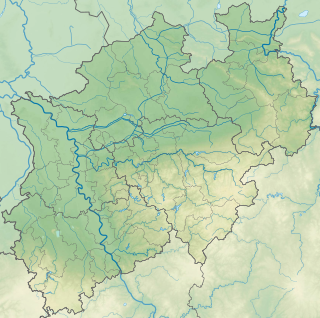Märkisches layer rib land
| Märkisches layer rib land | |||
|---|---|---|---|
| Systematics according to | Handbook of the natural spatial structure of Germany | ||
| Greater region 1st order | Low mountain range threshold | ||
| Greater region 2nd order | Rhenish Slate Mountains | ||
| Main unit group | 33 → Süderbergland |
||
| About main unit | 337 → Bergisch-Sauerland lowlands |
||
| 4th order region (main unit) |
337 1 → Bergisch-Märkisches hill country |
||
| 5th order region | 337 1 .1 → Niederbergisch-Märkisches hill country |
||
| Natural space |
337 1 .13 → Märkisches stratified rib land |
||
| Geographical location | |||
| Coordinates | 51 ° 22 '7 " N , 7 ° 14' 57" E | ||
|
|||
| local community | Hattingen , Sprockhövel , Witten , Wetter (Ruhr) | ||
| state | North Rhine-Westphalia | ||
| Country | Germany | ||
The Märkische Layerrippenland is a natural spatial unit with the order number 337 1 .13.
The Märkische Layerrippenland extends in an east-west direction over the urban area of the cities of Hattingen (the entire southern urban area with the Elfringhauser Switzerland recreation area ), Sprockhövel (entire urban area with the exception of Haßlinghausen ), Witten (districts southeast of the Ruhr ) and Wetter (Ruhr ) (Districts of Wengern , Esborn , Albringhausen , Grundschöttel ). In the north lies the Ruhr valley (order number 337 1 .2), in the south the Haßlinghauser ridge (337 1 .15). In the west the stratified rib land , roughly separated from the Deilbach , merges into the Hardenberger Hügelland (337 1 .12), in the northwest lies the Vossnacken (337 1 .11) and the Ruhr stratified rib land (337 1 .14) and in the east in the Ruhr valley the Ardeypforte (337 1 .4).
The Märkische Layerrippenland is an extremely well-structured hilly country with narrow ridges running in the direction of the Rhenish Slate Mountains from southwest to northeast , which alternate with parallel depressions . From south-east to north-west , the terrain gradually changes from 300 m to 200 m. The predominant folded rocks of the productive carboniferous , sandstones , quartzites and conglomerates , are hard and emerge on the weathered ridges . In the depressions there are soft clay and brick slates , as well as mudstone . Seams of lean coal strike in the natural area and were mined early .
The area drains into the Ruhr according to the incline to the north. When the mountain ranges broke through, the main rivers formed deep narrow valleys, the tributaries of which are often separated by valley watersheds . While the ridges and their steep-walled slopes are often wooded, there are cleared areas in the depressions and flatter slopes that are mainly used for agriculture.
